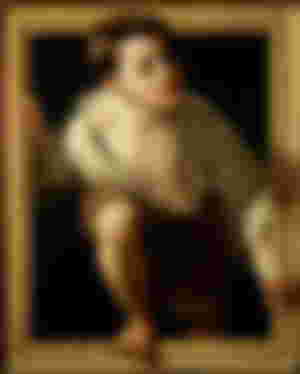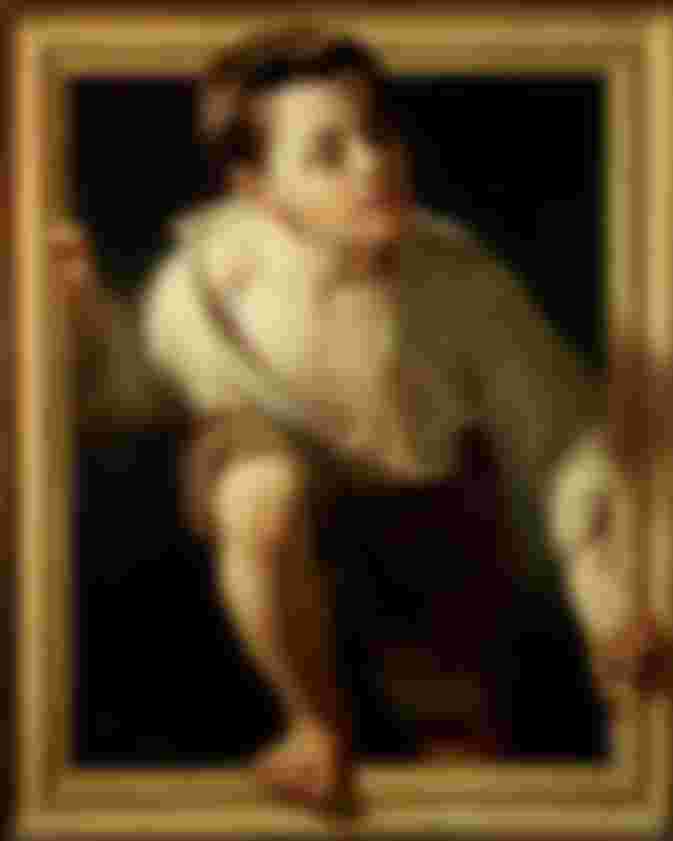Escape from Criticism
Spanish artist Perriel del Caso, 1874 AD.
This painting is a good example of the art of tromple, which is the use of realistic images to create a kind of optical illusion in which things appear in a three-dimensional field instead of only two dimensions, in order to add another axis of vision that does not exist.
This type of optical illusion adds ambiguity to the boundary between the real and imaginary void. The painter here is trying to fool our eyes by creating a kind of disguised visual illusion by transforming rigid materials, such as wood, marble, and paint, into a way to enhance his understanding of the world.
Here we see a young boy in shabby clothes stepping outside the frame of the plate he is part of in a desperate attempt to escape. His face shows signs of fear or trauma. The position of the hands, feet, and head outside the painted frame, as well as the shadows falling on them, create the illusion that the person climbs out of the plate.
The colors in the image are mostly yellow. The light comes from the left to attract the eye to the person's face.
In reality, the meaning of the painting is neither known nor intended. But its title may suggest the struggle and effort that young painters make when subjected to severe criticism by those who call themselves vocal critics of art.
In the time of the painter, conservative art critics preferred to see paintings filled with images of heroes and promote moral values, ignoring the vitality and activity of the real world.
The art of Trumpble itself is very old. Once upon a time, Plato wrote: Everything is deceived .. mesmerized at the same time. ”In the world of art, this idea is clear and explains itself. There are early examples of tromple that can be found in ancient Roman and Greek art, such as the famous Pompeii murals depicting scenes of nature Imagine.
It can also be said that the trumpble is a game practiced by the painter with the recipient to raise questions about the nature of drawing and perception and about our perspective on things, such as where does the painting end and where does the real world begin? The goal is to learn to see things with a new perspective and to accept and coexist with the idea that what we receive is limited by the area of the image or its visual scope.
In the nineteenth century, English naturalists adopted this type of illusion when they used colors, shapes, and unrealistic perspectives in order to demonstrate their intelligence and ingenuity and to create a kind of influence on the mind and awareness of the recipient.
Dutch 17th-century Dutch naturalists also employed this type of deception or delusion in the works of silent nature. They used to draw fruit fruits on silver plates, so that the dishes overlapped with the table placed on top, giving a sense of depth and as if it were a 3D painting.
However, some art historians bring the idea of artistic illusion back to an older time, specifically to the fifth century B.C. The Roman historian Pliny "or Pliny the Elder" in his book "Natural History" wrote about a legend that tells of an art competition between the two greatest Greek painters of the time, Paracius and Xuixes.
Both were painted on wood planks and on the walls. They were also believed to be the greatest painter. Therefore, they decided to settle the matter and judge the public in a drawing competition, at the end of which it is decided which one deserves the title. Each of them chose a side of a wall to draw on it so that they would not see each other. And they chose a number of people to be arbitrators.
Both Parasius and Xuxus were brilliant in the trumpet. Each of them completed their work and then covered it with a curtain.
When Zeuxes presented his mural, he turned out to be a simple pottery with mixed fruit. What he accomplished was a silent nature beautifully painted. It also made the sun shine on the pale green surface of the pears, so that they looked both wet and firm. As for the pomegranate, he painted it so wonderful that the arbitrators and the spectators could have practiced its fruits almost.
People were astonished by the ingenuity and mastery of Zeoxis. As they were standing in front of his painting, a bird appeared, which had landed on the wall up and flew down to where the fruit bowl was drawn, wishing itself to pick up some grains and fly it away. However, the bird's head collided with the wall and fell to the ground, dying a victim of delusion.
The work of Zeoxis was very realistic. He was sure he would win the title, regardless of what his opponent would do.
Then the arbitrators moved to the other side of the hidden wall to see what Paracius drew on it. They asked him to remove the curtain, and he said that it was not possible. The audience was surprised by his words. But he turned around, saying that the curtain is the painting that he drew!
Although the painting of Zeoxis deceived the bird with its extreme realism, the Parasius Curtain was so realistic that it deceived or deluded the Zeuxis, the rulers and the public together. The competition ended with the proclamation of Parasius as the greatest painter.
Perriel del Caso is a relatively unknown painter. But he was born in the Spanish province of Catalonia. He lived from 1835 to 1910. His father worked as a carpenter and the son learned how to handle wood.
Then he went to Barcelona to receive a training at the Arts School there. He distanced himself from the romance that dominated school education at the time and rejected idealistic forms. At that time, students were encouraged to draw scenes of the outdoors and daily life.
Borel drew religious views, most of which are found today in the Barcelona Museum. Later on, he established his own painting academy, and he provided students with training and lessons in realistic painting. He also encouraged them to leave the classroom and draw in the open air.

